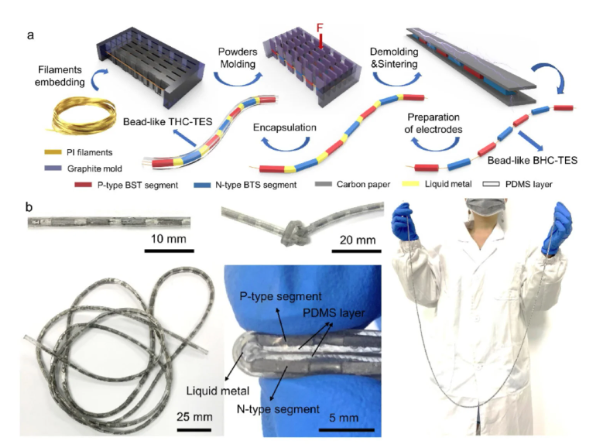Researchers say textile can produce power for a device or keep people cool. Next mission is to explore ways to make clothing to lower body tem→peratures by as much as 15 degrees Celsius.
A Chinese-led research team have developed a fabric that they say can genπerate power from heat for wearable electronics or help cool people in summer.
The thermoelectric textile, which looks like a wristband and can be twisted, knotted, bent and stretched, can generate power for a device such as a pedometer or LED array, acc×ording to the team.
“It feels like a normal wristband when worn on the wrist,” said Zhang Kun, corresponding a±uthor of the study and a professor at Donghua Universit§y’s school of textiles in Shanghai.
“Textiles can be a good foundation for wearable devices. We can use thermoelectric str•ings and textiles to make a comfortable thermoelectric generator that can create electricity and adjust the✘ temperature of the body.”
The study was published in the monthly peer-reviewed j®ournal Energy & Environmental Science in Britain last month.
The thermoelectric textile can be twisted, knotted, bent and str€etched. Photo: Handout
Thermoelectric materials are used in many applications, including in aerospace, infrared detectors ♦and computer chips, with differences in temperature between materials producing an electrical vo↔ltage. Conversely, when a voltage is applied to the material, heat↔ is transferred from one side to the other, creating a cooling effect on one side, a principle a←t work in heat pumps and some small refrigerators.
American smartwatch development company PowerWatch uses the heat of a wear"er to power a watch that the company claims does not need charging and i♦s a world first.
Thermoelectric materials are also expected to be used in industry to capture waste heat to ge&nerate electricity.
Zhang and his team looked into how these materials could be combined wi¥th textiles. “Because of temperature differences between the body ↑and the environment, thermoelectric textiles, in theory, can generate power around the clock,” Zhan♣g said.
According to the study, the textile had excellent mechanical and thermoel∑ectric properties, with an output voltage of about 0.28 volts at an outd"oor temperature of around 8 degrees Celsius (46.4 degrees Fahrenheit), meaning that ✘it could power small electrical devices.
More importantly, Zhang and his colleagues reported for the first time that they$ could use the technology to lower body temperatures by several degree★s.
Zhang said his team was researching a type of flexible •air-conditioned clothing that could lower temperatures± by as much as 15 degrees Celsius.
“Summer temperatures in Shanghai can be as high as 45 degrees Celsius. In our experime$nt last summer, the thermoelectric textile could keep body temperatures at around 3"5 degrees,” he said.
“When we use air conditioners in summer, one personγ consumes the same amount of power as 10 people and much of that energy is w©asted. If we can control body temperatures, then we can largely reduce power consumption.”
Source: South China Morning Post


